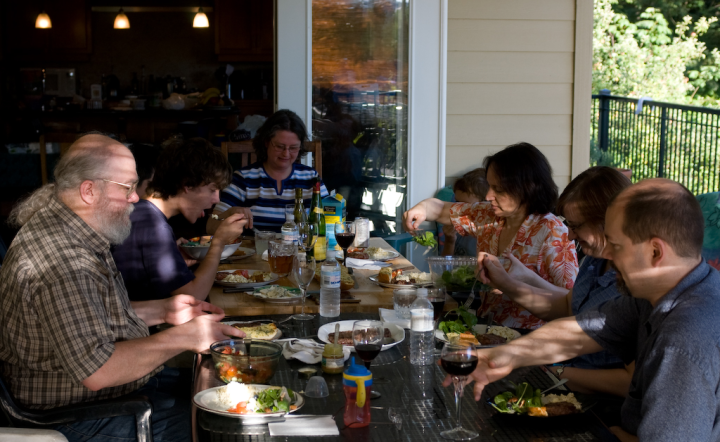
One of those great summer days. Baseball, happy boys, good food, and sunlit flowers, all among friends.
The boy and his friend and I went to the local Single-A ball game with our friends Peter and Kim and their University-age son Graham. The baseball was abominable, there were 5 hit batters in the first couple of innings. But the company was good, and we had shady seats with a good view on a nice warm day. And it was a treat to listen to the two eight-year-olds’ unselfconsciousness immersion into the game and the atmosphere, and the endless flow of almost entirely content-free chatter. Then we all went for dinner with some other guests down at Peter and Kim’s place.
Peter is a terrific cook. Historical note: this picture depicts three people who served on the original XML Working Group: Peter Sharpe, Lauren Wood, and Tom Magliery, and was taken by a fourth.
I don’t normally try to photograph food, but the sun was shining across the plate in a way that I found fetching.
Peter and Kim have flowers on their big patio. Alex Waterhouse-Hayward has recommended that I shoot flowers in shade not sun, and he knows more about photography than I ever will, but my eyes can’t resist flowers that have the shadows of other flowers on them.
Comment feed for ongoing:
From: Alex Waterhouse-Hayward (Aug 07 2007, at 08:24)
Photographic "rules" are there to be interpreted and broken. Taking photographs of flowers and gardens can have a double duty. One could be that of accuracy. The other (and just as legitimate) is one of artistic interpretation. When one photographs (or scans) flowers for accuracy, extreme contrast prevents a view of the flower that shows all of its attributes. One need not shoot on a cloudy day or in the shade to avoid contrast. A similar low contrast situation exists early in the morning and late in the evening of a sunny day. A plus to shooting plants and gardens in low contrast lighting is that sometimes an accurate interpretation comes hand in hand with the beauty of an artistic one.
Before the advent of digital cameras both Kodak and Fuji came out with higher contrast slide film and colour negative film. These films produced more punch, more zing and people got used to them. We who shot for magazines could not use these films as contrast has always been an enemy of magazine (and newspaper) reproduction. The trend toward these bright contrasty scenes has not diminished with digital cameras. But then most people view these pictures on a computer monitor. The ability of monitor to show all those shades of colour is somewhat less than that of a good projected transparency or that of well printed light jet print.
Alexwh
[link]